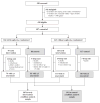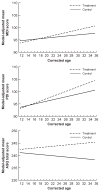Development of children at risk for adverse outcomes participating in early intervention in developing countries: a randomized controlled trial
- PMID: 24811237
- PMCID: PMC4821400
- DOI: 10.1111/jcpp.12247
Development of children at risk for adverse outcomes participating in early intervention in developing countries: a randomized controlled trial
Abstract
Background: Previous research has indicated positive effects of early developmental intervention (EDI) on the development of children in developing countries. Few studies, however, have examined longitudinally when differential treatment effects may be observed and whether differential outcomes are associated with exposure to different risk factors and country of implementation. Also, birth asphyxia as a risk condition has not been well studied. To address these limitations, we conducted a randomized controlled trial to test the hypothesis that there will be differential developmental trajectories favoring those who receive EDI versus a health education intervention in children in rural areas of India, Pakistan, and Zambia.
Methods: Children with and without birth asphyxia were randomized to EDI or control intervention, which was implemented by parents who received training in biweekly home visits initiated before child age 1 month and continuing until 36 months. Development was assessed in 376 children at ages 12, 24, and 36 months using the Bayley Scales of Infant Development and Ages & Stages Questionnaire administered by evaluators blind to intervention assignment and risk condition.
Results: Longitudinal mixed model analysis indicated that EDI resulted in better development over 36 months in cognitive abilities, regardless of risk condition, maternal resources, child gender, or country. Psychomotor development and parent-reported general development showed similar trends as for cognitive abilities, but were not statistically different between intervention conditions. Developmental differences were observed first at 36 months of age.
Conclusion: Early developmental intervention has promise for improving development in children across developing countries when exposed to various risk conditions. EDI should be one prominent approach used to begin to address long-term outcomes and intergenerational transmission of poverty.
Keywords: Early developmental intervention; at risk; birth trauma; low resource countries.
© 2014 The Authors. Journal of Child Psychology and Psychiatry. © 2014 Association for Child and Adolescent Mental Health.
Conflict of interest statement
Conflicts of interest statement: No conflicts declared.
Figures


References
-
- Al-Macki N, Miller SP, Hall N, Shevell M. The spectrum of abnormal neurologic outcomes subsequent to term intrapartum as phyxia. Pediatric Neurology. 2009;41:399–405. - PubMed
-
- Bao X, Sun S, Yu R, Sun J. Early intervention improves intellectual development in asphyxiated newborn infants. Intervention of asphyxiated newborn infants cooperative research. Chinese Medical Journal. 1997;110:875–888. - PubMed
-
- Bayley N. Bayley scales of infant development: Manual. New York: Psychological Corporation; 1993.
-
- Black RE, Cousens S, Johnson HL, Lawn JE, Rudan I, Bassani DG, … Mathers C for the Child Health Epidemiology Reference Group of WHO UNICEF. Global, regional, and national causes of child mortality in 2008: A systematic analysis. Lancet. 2010;375:1969–1987. - PubMed
Publication types
MeSH terms
Grants and funding
- HD034216/HD/NICHD NIH HHS/United States
- HD40607/HD/NICHD NIH HHS/United States
- U24 HD092094/HD/NICHD NIH HHS/United States
- HD40636/HD/NICHD NIH HHS/United States
- U01 HD043464/HD/NICHD NIH HHS/United States
- U01 HD040607/HD/NICHD NIH HHS/United States
- HD43464/HD/NICHD NIH HHS/United States
- HD42372/HD/NICHD NIH HHS/United States
- UG1 HD034216/HD/NICHD NIH HHS/United States
- U01 HD042372/HD/NICHD NIH HHS/United States
- U01 HD040636/HD/NICHD NIH HHS/United States
- U10 HD034216/HD/NICHD NIH HHS/United States
- TW006703/TW/FIC NIH HHS/United States
- R21 TW006703/TW/FIC NIH HHS/United States
LinkOut - more resources
Full Text Sources
Other Literature Sources
Medical

